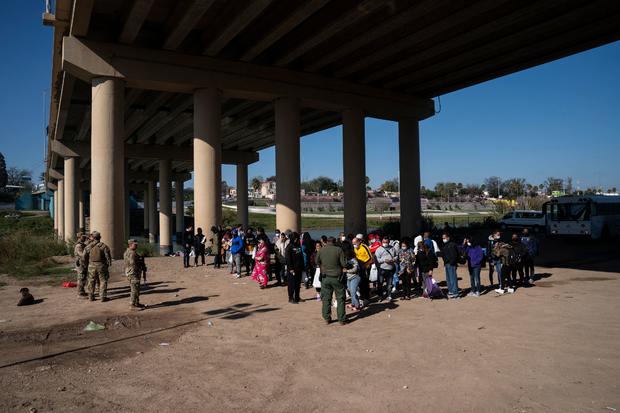Washington — The number of migrants processed by U.S. authorities along the southern border soared to a monthly record high in December, before President Biden announced tougher enforcement measures that have reduced illegal entries, government figures released Friday show.
Customs and Border Protection (CBP) officials at the U.S.-Mexico border processed migrants 251,487 times last month, a 7% increase from November, fueled by record arrivals of migrants from Cuba and Nicaragua, according to the agency statistics. The previous monthly record was set in May 2022, when CBP recorded over 241,000 migrant encounters along the southern border.
But the sharp increase in unlawful border crossings in December occurred before the Biden administration launched a revamped migration plan that pairs increased expulsions of those entering the U.S. unlawfully with expanded opportunities for vulnerable asylum-seekers and migrants with U.S.-based sponsors to enter the country legally.
VERONICA G. CARDENAS/AFP via Getty Images
Since those measures were announced in early January, the number of migrants apprehended along the Mexican border has plummeted. Border Patrol is currently averaging roughly 4,000 migrant apprehensions per day, a 40% drop from the daily average in December, a senior Department of Homeland Security official told CBS News Friday, requesting anonymity to share internal data.
Still, the record number of migrant apprehensions in December, a month that has historically seen lower migration flows than warmer parts of the year, illustrates the unprecedented migrant crisis along the southern border, where migrants have been arriving in greater numbers and from more countries than ever before.
The extraordinary migration event has been primarily driven by record arrivals of migrants from countries outside of Mexico and Central America’s Northern Triangle, the main sources of U.S.-bound unlawful migration before the COVID-19 pandemic.
In December, U.S. officials along the Mexican border recorded 42,637 encounters with Cubans, and 35,389 encounters with Nicaraguans, all-time monthly highs for both nationalities. By contrast, U.S. border agents processed migrants from Guatemala, Honduras and El Salvador nearly 33,000 times last month.
U.S. border officials were preparing in late December to discontinue a pandemic-era rule known as Title 42 that has allowed them to quickly expel some migrants without affording them an opportunity to request asylum. But the Supreme Court put Title 42’s termination, ordered by a lower court, on hold while it reviews a request by Republican-led states that want the Trump-era policy to continue.
As part of the strategy Mr. Biden unveiled in early January, the U.S. announced that Mexico had agreed to accept 30,000 returns per month of migrants from Cuba, Haiti, Nicaragua and Venezuela who attempted to cross into the U.S. illegally. Previously, Mexican officials generally only accepted the return of migrants from Mexico, Guatemala, Honduras and El Salvador expelled under Title 42.
The Biden administration simultaneously committed to admitting up to 30,000 migrants from Cuba, Haiti, Nicaragua and Venezuela per month and giving them access to work permits if they have sponsors in the U.S. willing to support their arrival. Officials also announced a process for vulnerable migrants in Mexico to make appointments through a mobile app to request U.S. entry at ports of entry along the southern border.
In December, U.S. border officials carried out 49,405 expulsions under Title 42, representing only 20% of all migrant encounters last month. That percentage, however, could change in January since Mexico has since accepted the return of additional migrant nationalities expelled by the U.S. via Title 42.
Migrants who are not expelled are processed under regular immigration law, which allows them to request asylum. Migrant adults and families could be detained, deported under a process known as expedited removal or released into the U.S. with a court notice or instructions to check in with federal officials in their respective destinations. Unaccompanied children are generally transferred to government shelters.
Migrant encounters do not represent individual migrants, as some try to cross the U.S. border multiple times after being expelled to Mexico. In December, 14% of migrants processed along the southern border had been previously stopped by U.S. immigration officials in the last 12 months, CBP data show.
Moreover, not all migrants enter the U.S. illegally between legal ports of entry. In December, U.S. border officials processed 23,025 asylum-seekers determined to be vulnerable at ports of entry under humanitarian exemptions to Title 42, according to government data submitted to a federal court.

